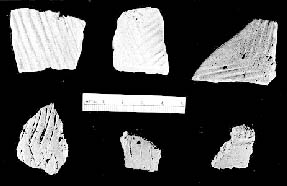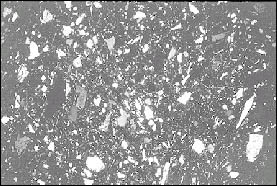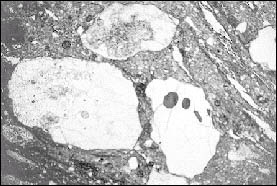by James B. Stoltman, University of Wisconsin-Madison
Note: The Icehouse Bottom site is located in Monroe County, Tennessee, near the town of Vonore. It was excavated prior to the construction of Tellico Dam by the Tennessee Valley Authority (TVA) and today is underwater.
Recent analysis of pottery originally recovered from Icehouse Bottom by Jefferson Chapman, now McClung Museum Director, in 1970-1971 has further enhanced the site’s standing as one of the most important Middle Woodland sites in eastern North America. This site is noteworthy for it’s early maize—reliably dated to the second century AD—and for an unusual number of prismatic blades of Flint Ridge chalcedony that are definite markers of interaction with the Hopewell centers of Ohio. The new evidence from pottery confirms that ceramic vessels were also exchanged in two directions between Ohio and the Little Tennessee Valley.
The new findings emerged from an investigation of the extent to which ceramic vessels were involved in the extensive network of cultural interaction that occurred between the Southeast and Ohio during the first few centuries of the Christian era. This network of cultural interaction also saw the circulation of substantial amounts of raw materials and commodities such as marine shell, mica, and Flint Ridge chalcedony. The technique used to investigate this problem was ceramic petrography, which requires the sacrifice of a small portion of a ceramic sherd. Basically a geological technique, ceramic petrography is the most powerful and reliable technique available for identifying mineral and rock inclusions found in pottery. A sliver of a sherd is cut off, glued to a glass slide, and then ground down to a specified thickness (.03 mm) to form a thin section. The thin sections are then viewed through a petrographic microscope in which light is transmitted through the specimen from below. Since at this thinness most minerals allow the passage of some light, but in distinctive ways depending upon the specific mineral, one can reliably identify the mineral and rock types present. The relevance of these observations to the archaeologist is that the mineral and rock types present in sherds, whether intentionally added by the potters as “temper” or natural inclusions within the clays, are potentially unique to specific locales. Thus, it is theoretically possible to identify the place of manufacture of a ceramic vessel.

Figure 1. Six Icehouse Bottom Sherds Studied
Sherds from twenty-nine Icehouse Bottom vessels were generously provided by the McClung Museum for thin section analysis. On stylistic grounds, twenty-six of these vessels were believed of local manufacture, while three with rocker-stamped decoration were suspected Ohio imports (Figure 1). Figure 1, below, shows six Icehouse Bottom sherds thin-sectioned for this study. The top row contains local Connestee simple stamped sherds, and the bottom row shows rocker-stamped possible Ohio imports. The twenty-six local vessels were equally divided between two main Middle Woodland ceramic series at the site, Candy Creek (limestone tempered) and Connestee (sand tempered).
The most useful vessels for identifying locally produced ceramics proved to be the Connestee vessels. Nine of these were extremely homogeneous, containing a series of distinctive minerals, notably clinozoicite (of the epidote family), mica, and amphibole, probably derived from local metamorphic rocks. Besides the distinctive minerals, the relatively small size of the individual grains (mean size < 0.25 mm), their generally monomineralic character, high angularity, and relatively high density (ca. 25 grains/cm2) combine to provide an apparently reliable signature for Icehouse Bottom ceramics (Figure 2). Importantly, two simple-stamped vessels from the Seip site in Ross County, Ohio, also thin sectioned for this study, had the identical minerals, confirming that Icehouse Bottom vessels had reached southern Ohio during Hopewellian times.

Figure 2. Thin section photomicrograph of a local Connestee vessel at 10X under crossed polars. Scale: Chert grain (speckled) SW of center = .25 mm.
The three rocker-stamped sherds suspected of being of Ohio origin (Figure 1, bottom row) were selected from twenty-one sherds comprising nine vessels recovered at Icehouse Bottom. Second only to the nearly 100 such sherds comprising a minimum of eight vessels from the Garden Creek site in North Carolina, this total constitutes the greatest number of potentially imported Ohio Hopewell ceramics so far reported in the Southeast.
Results of the petrographic analysis of these three sherds, believed to be from separate vessels, suggest that two were imported. These two vessels (Figure 1, bottom row, left and right) were tempered with coarsely crushed granitic rock dominated by quartz and various feldspars poorly represented in the Icehouse Bottom vessels. Figure 3 shows a thin section photomicrograph of the rocker-stamped sherd in the lower left of Figure 1. As can be seen from Figure 3 in contrast to Figure 2, the individual temper grains are much larger (mean size > .50 mm), polymineralic in character and less dense (ca. 20 /cm2). By contrast, the third rocker-stamped vessel (Figure 1, bottom row, center) was sand tempered and probably made locally. It is not quite like any other vessel from the site, but the presence of some clinozoicite suggests local production.

Figure 3. Thin section photomicrograph of a rocker-stamped sherd at 10X under plane polarized light. Scale: Largest grain (mostly microcline) = 1.8 mm.
While the two grit-tempered vessels are compositionally unlike any of the local ceramics from Icehouse Bottom, it is more significant to note that they simultaneously resemble vessels from Ohio. Nearly identical compositions have been observed in thin-sectioned vessels from the Harness mound group, one of the great Hopewell earthwork sites in southern Ohio. Thus, the current study has been able to document two basic points:
- Some of the long-suspected Southeastern ceramic imports recovered in Hopewell sites in Ohio—at least two vessels from Seip—were actually manufactured at or near Icehouse Bottom.
- At least two rocker-stamped vessels recovered at Icehouse Bottom were, indeed, originally manufactured in Ohio.
For the present, at least, this makes Icehouse Bottom unique. It is the only site in the Southeast (including Garden Creek, where thin section analysis of eight rocker-stamped vessels from that site showed that all were made of local materials) at which the presence of actual trade vessels from Ohio can be documented.
References
Chapman, Jefferson. 1973. The Icehouse Bottom Site, 40MR23. Department of Anthropology Report of Investigations No. 13. University of Tennessee, Knoxville.
Keel, Bennie C. 1976. Cherokee Archaeology. The University of Tennessee, Knoxville.
Prufer, Olaf H. 1968. Ohio Hopewell Ceramics. Museum of Anthropology Anthropological Papers No. 33. University of Michigan.
Stoltman, James B. 1991. Ceramic Petrography as a Technique for Documenting Cultural Interaction: An Example from the Upper Mississippi Valley, American Antiquity, 56: 103-121.